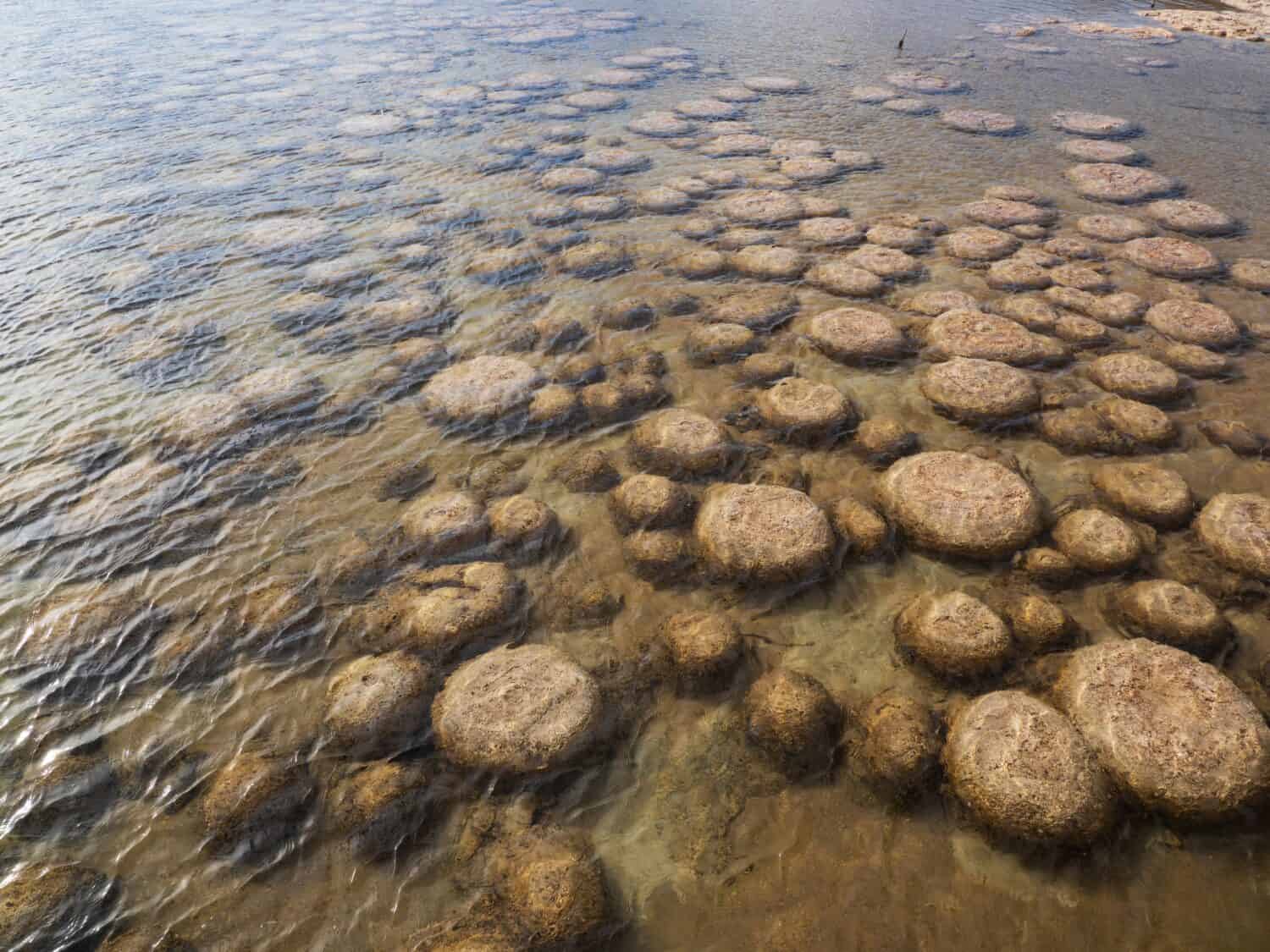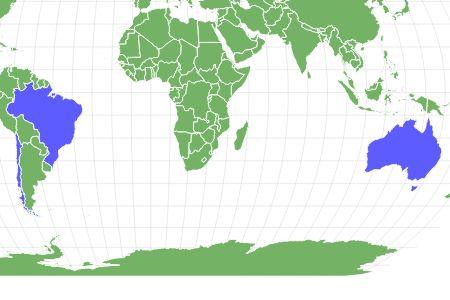Stromatolites played a key role in the development of life on Earth.
Advertisement
Stromatolite Scientific Classification
- Kingdom
- Animalia
Read our Complete Guide to Classification of Animals.
Stromatolite Conservation Status
Stromatolite Facts
- Fun Fact
- Stromatolites played a key role in the development of life on Earth.
Stromatolite Physical Characteristics
View all of the Stromatolite images!
Stromatolites are layered sedimentary formations formed by microscopic bacteria. These living fossils are the oldest lifeforms on the planet and also one of the rarest. Stromatolites are created by photosynthetic microorganisms such as Pseudomonadota, cyanobacteria, and sulfate-reducing bacteria. These microorganisms produce an adhesive solution that cements sand and other sediments into mineral layers. Over time, this process creates “microbial reefs” in shallow water that can grow up to a meter or more.
Quick Facts
- Stromatolites hold the title of the oldest living fossils on Earth, dating back more than 3 billion years.
- It can take anywhere from 2,000 to 3,000 years for a stromatolite to grow to a meter in size.
- Stromatolites produce oxygen and helped ancient life to grow and evolve billions of years ago.
- Stromatolites require highly-saline water to survive, as the high levels of salt restrict other competing lifeforms that can damage the stromatolites’ structure.
- Climate change and extreme weather events threaten the few remaining stromatolites as flooding and runoff can damage the delicate structures.
What Are Stromatolites?
Stromatolites are neither plants nor animals. Rather, they are layered, microbial, accretionary structures. These living fossils consist of layers of sedimentary rock cemented between sticky microbial films produced by these bacteria. This layered structure represents the key feature of all stromatolites. However, no one structure exists, meaning that they can take many forms. Some appear as columns (columnar), domes (domal), or pyramids (cononical), while others take on branching, or stratiform shapes. Still, others can look like flat discs or donuts with the center hollowed out. Different types can occur in the same location, which indicates that specific conditions alter a stromatolite’s morphology, including water depth, biological activity, and other environmental factors.

Stromatolites are layered sedimentary formations formed by microscopic bacteria.
©James St. John / Flickr – License
Formation
Stromatolites develop extremely slowly, which makes studying their formation difficult. To remedy this, scientists use time-lapse photography to study how stromatolites develop in a laboratory over time. Scientists discovered that exposing cyanobacteria to localized light enticed the bacteria to move toward the light. In addition, the cyanobacteria increased their photosynthetic yield. These bacteria actively seek out light in order to ensure the continued survival of the colony. The bacteria produce adhesive compounds that trap nearby sediment and other rocky materials as they move toward the light. Over time, the trapped sediment gets cemented together in layers.
How Old Are Stromatolites?
The first stromatolites appear in the fossil record around 3 to 3.5 billion years ago during the Archean Eon. However, some scientists argue that these fossils are not stromatolites, but rather natural material depositions created by some other mechanism. What is known is that their distribution peaked around 1.25 billion years ago during the Proterozoic Eon.
The oldest modern stromatolites live in Hamelin Pool, a hypersaline recess in the coastline of Shark Bay, Australia. According to analysis, the stromatolites in Shark Bay are between 2,000 and 3,000 years old.

Hamelin Pool in Western Australia is home to stromatolites estimated to be between 2,000 and 3,000 years old.
©iStock.com/Claudia Schmidt
Where Can You Find Stromatolites?
During the Precambrian, you could find stromatolites throughout much of the world. This proved especially true around 1.25 billion years ago during the peak of stromatolite disbursement.
On the other hand, living marine stromatolites only live in a few locations around the world. All marine stromatolites living today can be found only in hypersaline lakes and marine lagoons. The high saline content of these habitats prevents animal grazing and protects them from damage. Hamelin Pool Marine Nature Preserve, Shark Bay in Western Australia, contains the largest and arguably best-preserved collection of stromatolites in the world. Other well-known locations include Papa del Tamarugal National Reserve in Chile, and Lagoa Salgada in Rio Grande do Norte, Brazil.
You can also find microbialites similar to stromatolites or thrombolites in various freshwater habitats worldwide. These include Lake Balacar’s giant 6.2 square-mile living microbialite bed. Located near Mexico’s border with Belize, the “Lagoon of Seven Colors” may rank as the largest living microbialite on Earth. Other known freshwater locations include giant, 40-meter-high microbialite towers in Lake Van in eastern Turkey, and Pavillion Lake in British Columbia, Canada.
Why Did Stromatolites Disappear?
Experts disagree as to what caused stromatolites to practically disappear from existence. Two competing theories provide different answers to this puzzling question. The first theory argues that complex grazing organisms emerged near the end of the Precambrian Era, around 1 billion years ago. Stromatolites fell victim to these grazers and only managed to survive in a few, hypersaline environments or remote freshwater lakes.
The second theory argues that foraminifera protozoans, such as amoebas and other single-celled organisms, facilitated the decline in stromatolites. Around the time that stromatolites started to disappear, new formations suddenly appeared called thrombolites. Like stromatolites, thrombolites are also microbial structures created by cyanobacteria. However, unlike stromatolites, which feature a layered structure, thrombolites feature no such structure, instead appearing as a clumpy mess. The theory goes that protists like amoebas and other forams led to the rise in thrombolites and the downfall in stromatolites. They did this by churning up marine sediment as they explored their surroundings. This churning encouraged the formation of thrombolites while discouraging the formation of stromatolites. Thus, stromatolites could only occur in hypersaline environments that offered them protection from these protists.

Thrombolites are also microbial structures created by cyanobacteria, but without the layering found in stromatolites.
©John W W/Shutterstock.com
Why Are Stromatolites Important?
Stromatolites played a key role in the development of life on Earth. Billions of years ago, the air contained only around 1% oxygen. This lack of oxygen prevented complex life from forming outside of the oceans. Thankfully, stromatolites produce oxygen just like plants as a byproduct of photosynthesis. For billions of years, stromatolites pumped oxygen into the oceans, which eventually escaped into the atmosphere. This allowed life to develop on land, paving the way for complex life forms, including humans!
Today, stromatolite fossils contain answers to some of the most important questions in geology, biology, evolutionary history, and the natural world. The few remaining living stromatolite fossils represent a link to our ancient past in addition to being living wonders. Their importance both to our past and our present makes preserving stromatolites worth the cost.
Up Next
- Ancient Oddities: 8 Extinct Sea Creatures
- 11 Ancient Mammals that Lived Alongside Dinosaurs
- 5 Gigantic Ancient Bears That Towered over Today’s
Stromatolite FAQs (Frequently Asked Questions)
Are stromatolites plants or animals?
Stromatolites are neither plants nor animals, but rather living microbial fossils created by photosynthetic bacteria.
Can you touch stromatolites?
Experts ask that you do not touch stromatolites, as touching them can damage their structure. Additionally, you should wash off before swimming in areas containing stromatolites to prevent chemicals on your body from polluting the water.
What do stromatolites look like?
Stromatolite structures take many forms, including stratiform, conical, domal, branching, and columnar shapes. Some look like columns or pyramids, while others look like discs or rings.
What’s the difference between thrombolites and stromatolites?
While stromatolites feature a layered structure, thrombolites feature no such structure, instead appearing as a clumpy mass. The link between thrombolites and stromatolites remains unclear. However, some scientists argue that the arrival of forams like amoebas and other single-celled organisms prompted stromatolites to give way to thrombolites.
Thank you for reading! Have some feedback for us? Contact the AZ Animals editorial team.
Sources
- Shark Bay World Heritage, Available here: https://www.sharkbay.org/place/hamelin-pool/
- BBC, Available here: https://www.bbc.com/travel/article/20210117-stromatolites-the-earths-oldest-living-lifeforms
- Wikipedia, Available here: https://en.wikipedia.org/wiki/Stromatolite

















